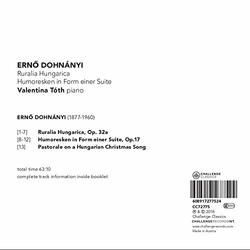| All Artists: Valentina Toth Title: Dohnanyi: Ruralia Hungarica; Humoresken in Form einer Suite Members Wishing: 0 Total Copies: 0 Label: CHALLENGE RECORDS Release Date: 10/19/2018 Album Type: Import Genre: Classical Styles: Forms & Genres, Suites Number of Discs: 1 SwapaCD Credits: 1 UPC: 608917277524 |
Search - Valentina Toth :: Dohnanyi: Ruralia Hungarica; Humoresken in Form einer Suite
 | Valentina Toth Dohnanyi: Ruralia Hungarica; Humoresken in Form einer Suite Genre: Classical Valentina Toth writes: Although they were not musically trained, my parents taught me to love Bartok and Kodaly. I treasured their music from the time I was young, and only became acquainted with Dohnanyis work much later,... more » |
Larger Image |
CD Details
Synopsis
Product Description
Valentina Toth writes: Although they were not musically trained, my parents taught me to love Bartok and Kodaly. I treasured their music from the time I was young, and only became acquainted with Dohnanyis work much later, when I came in contact with it by accident. It was romantic, virtuosic, and incredibly well written for the instrument. What more can you ask as a concert pianist? And although he may only seem rather less distinctly Hungarian than Bartok, many aspects of his country are reflected in his work. I remember when I was working on the Ruralia hungarica, my father recognized many of the melodies from the songs he had learned as a boy. Dohnanyi wrote Ruralia hungarica in 1923 and gave it a real Hungarian touch by including a wide range of folk melodies in all movements. The Humoresken Op. 17 from 1907 date from when he taught in Berlin. They are basically romantic in nature and now and then reminiscent of Brahms piano music. As the name suggests, these are more or less light-hearted character pieces, in which he draws on musical forms from the eighteenth century.
